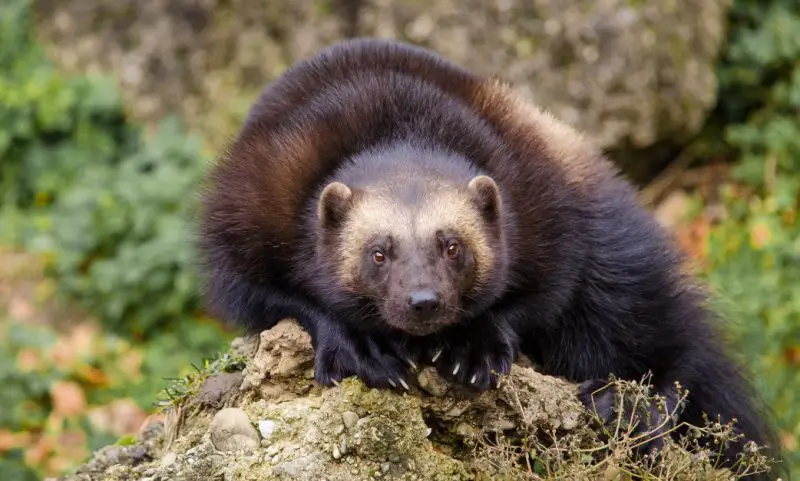Idaho’s backcountry is defined by steep mountain walls, glacial basins, and some of the most remote wilderness areas left in the lower forty eight states. Hidden deep within these rugged landscapes lives one of North America’s most powerful and mysterious mammals. The wolverine moves through Idaho’s snow covered peaks with an independence and stamina that few animals can match.
Most people never see a wolverine in the wild. They travel across enormous home ranges, avoid human activity, and stay active during the harshest winter conditions when few hikers venture outside. Yet every track left in soft powder or along a windswept ridge hints at a story of determination. Wolverines are shaped by deep snow, long winters, and the constant need to search for food across unforgiving terrain.
Idaho has become one of the last strongholds for wolverines in the United States. Its isolated mountain systems, persistent snowpack, and vast wilderness corridors create conditions that allow this elusive creature to survive. Looking closely at wolverines in Idaho reveals a species far more complex than the fierce reputation that often surrounds them.
Understanding Wolverines in Idaho

What Wolverines Really Are
Wolverines are the largest terrestrial members of the weasel family. Despite their modest size compared to bears or wolves, they possess an impressive combination of strength, endurance, and problem solving ability. Their bodies are heavily built, with short legs, powerful forelimbs, and broad paws that help them travel across deep snow.
Their dense fur protects them from wind, ice, and extreme cold, allowing them to remain active when many other mammals seek shelter. Wolverines move with a distinctive loping gait that conserves energy over long distances. This movement pattern is essential, because wolverines often cover dozens of miles in a single day across Idaho’s mountains.
Their intelligence is just as notable. Wolverines learn terrain features, revisit old food caches with remarkable accuracy, and detect buried carcasses under thick layers of snow. Every step they take reflects experience and knowledge of the land.
Why Idaho Provides Exceptional Wolverine Habitat
Idaho contains some of the most intact mountain ecosystems in the West. The state’s rugged geography includes massive forested slopes, high elevation basins, glacial lakes, and thousands of acres of wilderness preserved from development. These landscapes give wolverines the space and isolation they require.
Deep snow is critical for wolverine denning. Idaho’s central and northern mountain ranges maintain long lasting snowpacks, particularly in areas like the Sawtooths, the Salmon River Mountains, and the Bitterroots. These snow conditions help female wolverines dig stable dens in late winter when kits are born.
Idaho also supports abundant ungulate populations. Elk, deer, bighorn sheep, and mountain goats experience natural winter mortality, providing wolverines with reliable scavenging opportunities. Carcasses buried by snowstorms or avalanches serve as essential winter food sources.
Combined with remote terrain and natural corridors between mountain systems, Idaho offers one of the best remaining environments for sustaining a healthy wolverine population.
Where Wolverines Occur Across Idaho
Sawtooth Range and Sawtooth National Recreation Area
The steep granite peaks and deep valleys of the Sawtooths form a nearly perfect wolverine landscape. Snow accumulates heavily, and human disturbance remains relatively low outside of summer.
Salmon–Challis and Frank Church Wilderness
This region is famously remote. Wolverines roam across enormous distances here, taking advantage of rugged terrain, avalanche chutes, and limited human presence. The Frank Church–River of No Return Wilderness is one of the largest roadless areas in the country and functions as a major wolverine stronghold.
Bitterroot and Clearwater Mountains
Northern Idaho’s heavily forested mountains support wolverines throughout the year. The presence of high snowfields and scattered alpine basins creates ideal habitat conditions.
Selkirk Mountains
Near the Canadian border, the Selkirks host some of Idaho’s coldest and snowiest terrain. Wolverines move between Idaho, Washington, and British Columbia along these transboundary ridgelines.
Isolated Ranges of Central Idaho
Even smaller ranges such as the Lemhi Range and Lost River Range occasionally host wolverines. Their presence in isolated mountain “islands” shows just how capable they are of long distance travel.
Seasonal shifts influence where wolverines appear. Winter denning generally occurs above timberline in deep snowdrifts. Summer movements extend into lower forests, wetland edges, and avalanche paths where prey becomes more abundant.
Hidden Behaviors Most People Never Notice
Their Endurance Levels Are Remarkable
Wolverines are built for continuous movement. Their stamina allows them to travel over ridge after ridge without rest, investigating valleys, forests, cirques, and high plateaus in search of food. This lifestyle demands immense energy, yet wolverines maintain a steady rhythm throughout harsh Idaho winters.
Their movement patterns are not random. Wolverines follow natural travel corridors such as ridgelines, frozen river valleys, avalanche paths, and forest edges where scent trails and scavenging opportunities are more likely.
Their Sense of Smell Is Exceptionally Developed
Wolverines can detect food beneath several feet of compacted snow. This ability allows them to locate frozen carcasses from ungulates that died weeks earlier. Idaho’s recurring snowstorms and avalanches hide many potential food sources. Wolverines rely on scent and memory to uncover these winter resources.
Their exceptional sense of smell also helps them locate old caches they buried earlier in the season.
They Are Naturally Solitary
Despite their fierce appearance, wolverines prefer solitude. They avoid other wolverines except during the breeding season or when mothers raise kits. Maintaining a large territory reduces competition and ensures access to scattered food throughout Idaho’s mountains.
Although solitary, wolverines show surprising gentleness toward their offspring. Mothers guide kits across complex terrain, teaching them how to navigate snow, find food, and avoid predators.
Anatomy Built for Harsh Mountain Winters
A Coat That Defies Ice and Wind
Wolverines grow thick, layered fur that remains resistant to frost buildup. Even during blizzards or subzero nights, their coat keeps them insulated and dry.
Paws Designed for Snow Traversal
Their wide paws distribute weight effectively, acting almost like natural snowshoes. This adaptation allows them to run across surfaces where deer, elk, or even wolves struggle.
These same paws help them climb cliffs, trees, or the remains of avalanche debris to investigate potential food.
Powerful Jaws for Frozen Food
Wolverines possess jaw strength far beyond what their size suggests. They can crack bones, tear through frozen hide, and feed on carcasses locked in ice. In winter, this ability is lifesaving. Sparse prey availability makes frozen remains a crucial part of their diet.
Feeding Habits Across Idaho’s Mountains
Scavenging as a Primary Strategy
Wolverines are opportunistic carnivores that rely heavily on carrion. Winter storms, predator kills, and natural ungulate deaths all contribute to the food supply. They can smell and dig out carcasses buried deep in snow. In a season when fresh prey is scarce, scavenging becomes the foundation of survival.
Hunting Small Prey When Available
Although scavengers by necessity, wolverines can also hunt. They pursue snowshoe hares, ground squirrels, birds, and occasionally vulnerable ungulate calves. Their speed over snow gives them a temporary advantage in deep winter or early spring.
Food Caching
Wolverines often tear sections of meat and bury them under snow or debris. Idaho’s cold climate keeps these caches preserved for days or even weeks. Caching reduces the need for long distance travel during difficult weather conditions.
Reproduction and Family Life
Mating and Delayed Implantation
Wolverines mate in summer, but implantation of embryos is delayed until winter. This timing ensures that kits are born when snow density is high enough for stable dens.
Snow Dens for Raising Kits
Females create dens beneath deep drifts, tree root systems, old avalanche piles, or rocky cavities. These snowy chambers protect kits from freezing temperatures and predators.
Kit Development and Learning
Kits are born blind and helpless. By early spring, they venture out of the den and begin following the mother through her territory. They learn to navigate cliffs, read scent trails, locate scavenging sites, and cross snowfields. By summer, young wolverines travel confidently and gradually separate to establish their own ranges.
Wolverines Across Idaho Landscapes
High Alpine Cirques and Snowfields
These areas collect heavy snow and maintain cold temperatures, making them ideal denning locations. Wolverines frequently travel through cirques searching for carrion left by storms.
Steep Forested Slopes
Subalpine forests provide shade, cool temperatures, and access to prey and cached food. Wolverines thread through these forests quietly, often leaving minimal evidence of their presence.
Avalanche Paths
Avalanche chutes expose food buried beneath winter layers. Wolverines patrol these slopes regularly, especially in late winter and early spring.
Seasonal Rhythms in Idaho
Winter
Wolverines excel in winter conditions. They remain active when most predators struggle with deep snow. Winter also aligns with denning for pregnant females.
Spring
As snow melts, carcasses emerge and provide abundant food. Kits begin traveling outside their dens and learning essential movements.
Summer
Wolverines roam widely, sometimes crossing entire mountain ranges. They search for prey, investigate new territories, and cache food for unpredictable weather.
Autumn
Caching activity increases. Wolverines prepare for early snow and position themselves in areas with reliable winter food sources.
Interaction With Other Wildlife
Large Predators
Wolves, cougars, and bears often feed on the same carcasses. Wolverines rarely initiate conflict but are known for confidently defending food when necessary.
Ungulates
Deer, elk, and mountain goats indirectly support wolverines through natural winter mortality.
Birds of Prey
Ravens, eagles, and hawks often scavenge alongside wolverines or signal potential carcasses.
Myths and Misconceptions
Myth: Wolverines Are Aggressive Toward Humans
They avoid humans and rarely interact directly unless provoked.
Myth: Wolverines Are Common in Idaho
They remain rare and require extremely large territories, making encounters unusual.
Myth: Wolverines Regularly Hunt Large Animals
They scavenge far more than they hunt, particularly in winter.
Ecological Importance
Cleaning Up Carrion
Wolverines remove carcasses quickly, preventing disease spread and enriching nutrient cycles in mountain ecosystems.
Supporting Predator Networks
They influence how food sources move across landscapes, contributing to balance within Idaho’s carnivore community.
Indicators of Wilderness Quality
Stable wolverine activity reflects healthy, undisturbed mountain terrain with consistent snowpack.
FAQs About Wolverines in Idaho
Are wolverines dangerous?
No. They prefer solitude and avoid humans.
Where can I see a wolverine in Idaho?
The Sawtooths, Salmon–Challis region, Frank Church Wilderness, and the Bitterroots offer the best chances, though sightings remain rare.
What do wolverines eat?
Primarily carrion, supplemented with small mammals, birds, and the occasional ungulate calf.
Do wolverines hibernate?
No. They remain active year round, even during harsh winter storms.
Why are wolverines rare?
They require huge territories, depend on deep snow for denning, and have low reproduction rates.
Can wolverines climb?
Yes. They climb rocks, trees, and steep cliffs with surprising agility.
Conclusion
Wolverines represent one of the most compelling stories of wildlife endurance in Idaho. Their strength, independence, and remarkable ability to survive in extreme conditions make them a symbol of the state’s rugged wilderness. Understanding their lives helps reveal the intricate balance that shapes Idaho’s mountain ecosystems and highlights the importance of protecting these remote landscapes.
Idaho’s wolverines show us what it means for a species to exist at the edge of survival, guided by memory, instinct, and the enduring power of the mountains they call home.






